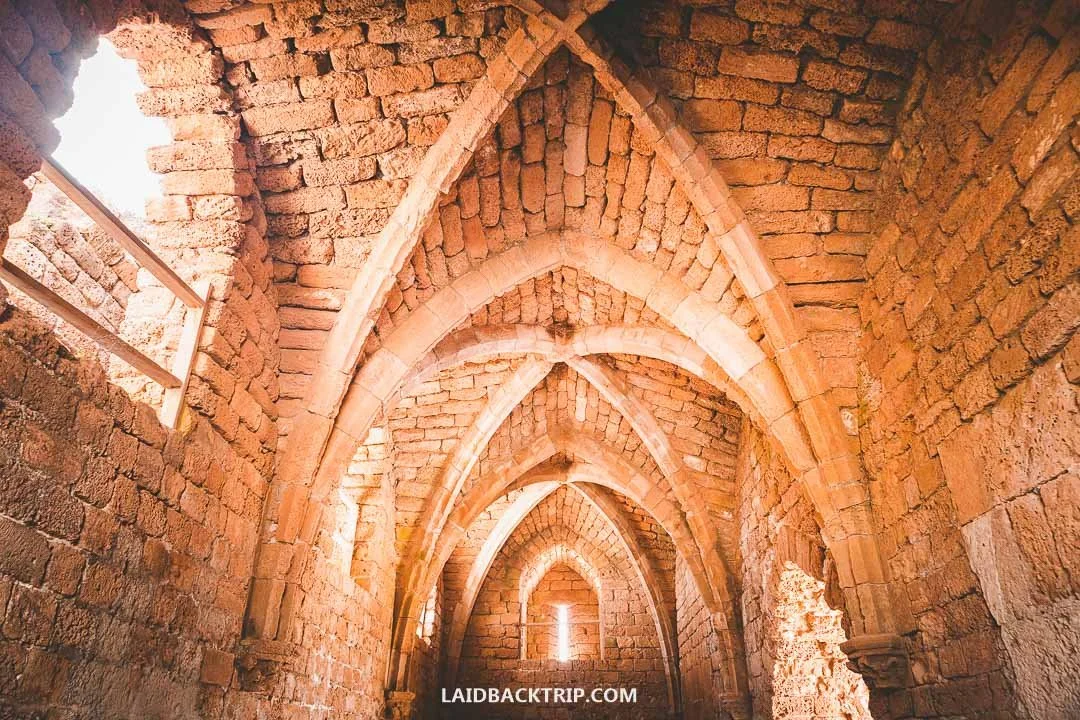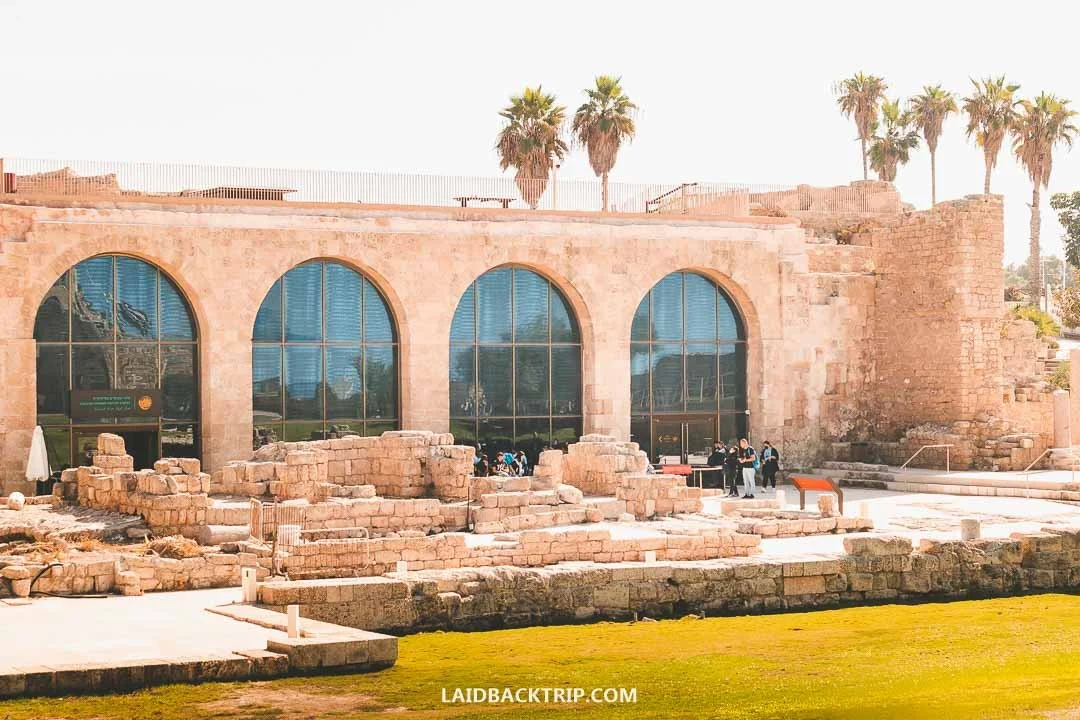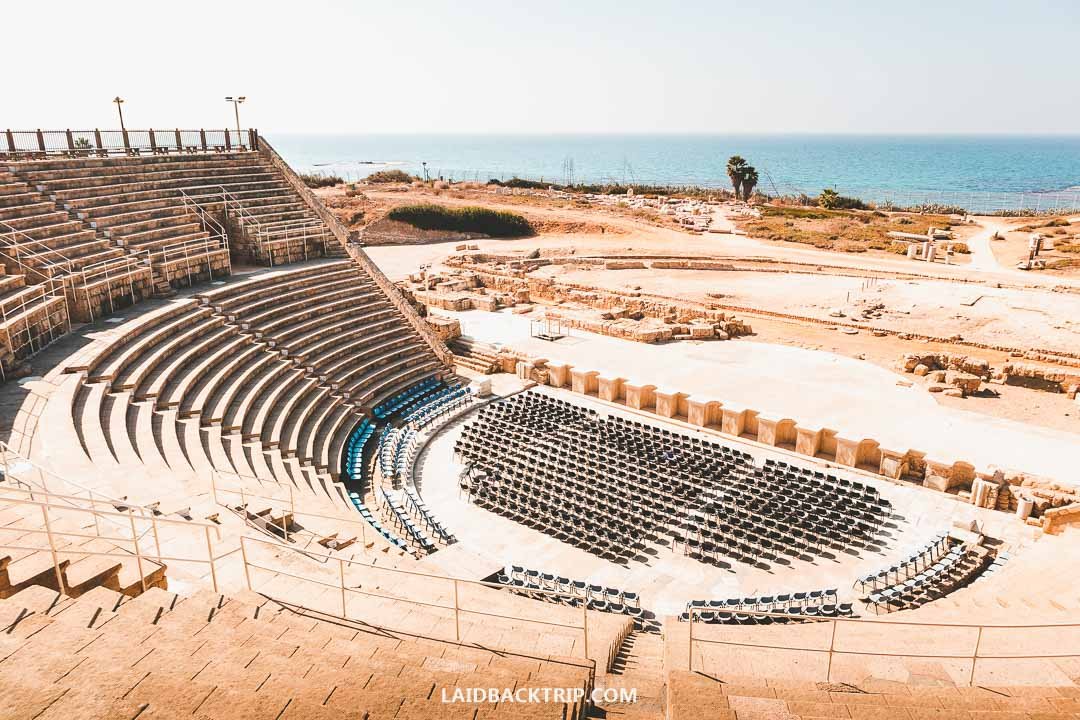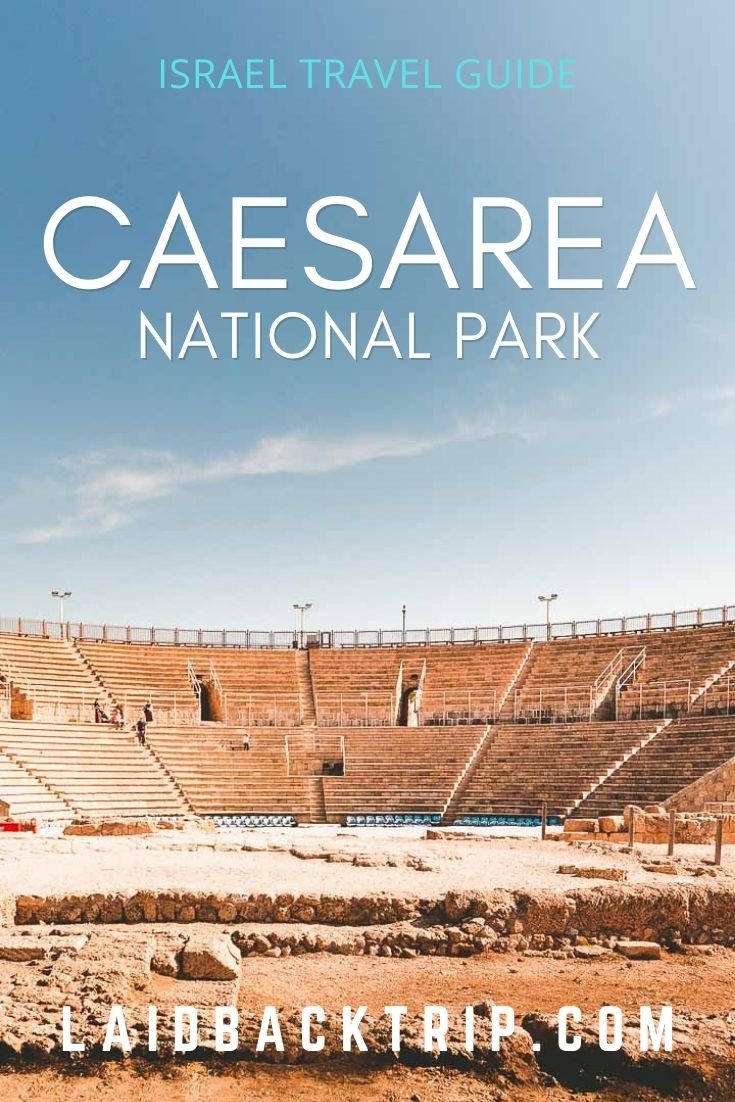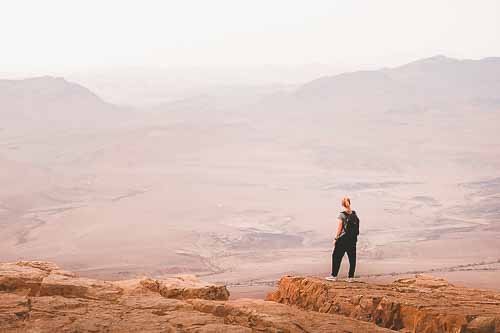A Guide to Caesarea National Park in Israel
Read our travel guide on Caesarea National Park in Israel. Includes what to see and do while there, tips on how to get, what to expect, where to stay, or when to go.
On the way from Tel Aviv to Haifa, the ancient city situated within Caesarea National Park is a must-visit place while visiting Israel.
Moreover, it's ranked among the top attractions in the Holy Land, so it would be a shame to miss the chance to explore it.
If it's still not enough, it is also one of the best and most important archaeological sites on Israel's Mediterranean coast.
With a history dating back to the 4th century BCE, Caesarea (also known as Caesarea Maritima or Caesarea Palaestinae) is not just another ruin in Israel.
It has everything you would expect from a place like this - a well-preserved Roman theater, huge hippodrome, ancient port, mosaics, columns, and beautiful sea views.
And we have to say that it was one of our favorite places we visited on our two-week trip to Israel.
After staying a few days in Tel Aviv and then a few more in Jerusalem, Caesarea National Park was the first proper tourist attraction we visited in Israel.
Exploring both cities was an unforgettable experience. However, it can also be quite overwhelming, and I have to admit that I really appreciated the change of scenery.
Dome of the Rock or Western Wall are incredible places, but they can be really crowded, and walking through the Jerusalems market with the hawkers everywhere is an experience on its own.
Caesarea was completely different. Serene, still, and without crowds.
Without further ado, here's everything you should know about Caesarea before you go.
History
In the 1st century BCE, Caesarea was built by Herod the Great, who named the city after Caesar Augustus.
Augustus was the first Roman emperor, and he gave the land to Herod the Great. Herod was the appointed king of Judea.
If the name sounds somewhat familiar to you, you should know that he also built Masada, the most famous attraction in Israel that's located outside Jerusalem.
While Caesarea underwent the most significant transformation and development under Herod the Great, the city was established in the location of a former Phoenician village.
The ancient port was known as Stratonos Pyrgos (Straton's Tower), and Straton I. of Sidon founded it in the 4th century BCE.
Later, it was a Jewish settlement for about two centuries until the Romans arrived.
The history of Caesarea Maritima is long and rich, and as we're not historians, we'll leave it to someone who's more educated on this topic.
We only hint that the characteristic Byzantine, Crusader, and Ayyubid periods played a vital role here. Later, the Mamluks destroyed the city, and it was deserted under Ottoman rule.
Things to Know Before You Go
When we saw Caesarea for the first time, we couldn't help to shake off the feeling that reminded us of Tulum.
While you might argue that the former Roman city is nothing like the Mayan ruins in Mexico and that we had probably spent too much time in the sun, we would disagree.
It was the coastal location that reminded us of the ruins with the views across the ocean we visited a few years back.
And that's also what makes Caesarea unique.
Regardless of our feelings and impressions, there are a few things you should know before visiting Caesarea.
Crowds
Due to its location, the main attraction amphitheater, and widespread popularity, Caesarea can be crowded, and it's not easy to avoid crowds here.
While we mentioned at the beginning of this blog post that our visit was very peaceful, it might be a different case for you.
It's better to come here early in the morning to avoid tours, events, and midday heat. This brings us to another topic that is tightly connected with crowds.
Events
Caesarea Theater (also known as amphitheater) is well-preserved and still used today, which sounds fantastic at first sight.
However, it might not be so great when you're a tourist as it can really complicate your plans.
Therefore, we would try to avoid the dates of any major event held here.
On the other hand, you can always buy a ticket and enjoy one of the shows yourself.
Orot Rabin Power Plant
One of the things that surprised us probably the most about Caesarea was the fact that there is a coal power plant nearby.
Seeing the centuries-old ruins, azure sea, and the tall chimneys in the backdrop is a truly unique combination.
It seems that the Israeli government is transforming the old and inefficient coal factory into a gas power plant, and it might change someday in the future.
The funny thing is, that not many pictures of Caesarea included the power plant on the backdrop, and although we understand why, we think it is good to know it is there.
How Much Time Do I Need
We spent at Caesarea a bit more than two hours, and that's what we feel is an adequate time for this site.
Of course, if you want to have a meal or drink in the restaurant or attend one of the shows, you will probably stay there longer.
However, two to three hours should be more than enough for most visitors.
If you're visiting Caesarea on a day trip from Tel Aviv (or even Jerusalem) by car, it might be a good idea to add some other interesting sites into your Israel itinerary.
Places such as Beit Shearim, Bahai Gardens, Nazareth, or even Akko are definitely worth visiting.
It would be best to have an extra day unless you want to make some hard choices and compromises, though.
Do I Need a Guide
No, you don't need a guide to visit Caesarea, and you can explore the site easily on your own.
However, a knowledgeable guide can bring even the most damaged ruins back to life.
As mentioned earlier, there is a lot of history hidden in Caesarea, so it might not be a bad idea to hire one. As usual, it's all about your preferences.
We didn't mind reading about Caesarea from the official sources, so we walked around the site without a guide.
What to See and Do
What might not be clear from the first impression is that Caesarea was, during the Roman and Byzantine periods, a flourishing port and prosperous city.
The site is packed with history and has some really cool structures.
In fact, it was the capital city of Judea during Herod's reign and the most important place in the country. Yes, even more important than Jerusalem.
Today, Caesarea is home not only to ancient structures and theater, but it also has restaurants, and it's ready for tourists.
How to Visit Caesarea
Visiting Caesarea National Park is very straightforward, so you don't need to stress too much about the planning part.
One of the most important things to know about Israel is that the country and its top attractions are very accessible, even to first-time visitors.
Still, we walk you through places we visited ourselves to help you plan your trip better.
Entrance
We rented a car in Jerusalem early in the morning and hit the road as soon as possible.
After about two hours, we finally reached Caesarea National Park.
We took Road 6511 from Or Akiva West Interchange and parked the car near the main entrance. There are three entrances at the site, but we believe it's better to start at this one.
We only showed our Israel Pass at the entrance gate and went inside.
Crusader Gate
Massive walls and deep moat still surround the city of Caesarea, and it's the first thing we saw before walking through the Crusader Gate.
They are also the most impressive structures in this area.
Louis IX built them in the middle of the 13th century after he retook the city from Saladin to prevent intruders from getting easily inside.
The most impressive part is that the walls and moat are exceptionally well preserved, and you can admire them even in the north and south areas of the city.
If you're interested in the Crusader era, don't forget to visit Nimrod Fortress in the Golan Heights.
Harbor and Old City
Once you enter Caesarea, you can explore the Old City first or head directly to the harbor.
Today the former Sebastos Harbor area is home to restaurants, galleries, souvenir stores, and other tourist facilities such as parking or toilets.
It has strong tourist vibes, but it also has a nice viewing platform, a visitors center located inside the ancient vaults, or Roman nymphaeum.
Visitors Center
Caesarea is one of the most visited attractions in Israel, and it has to cater to many visitors every day.
Therefore, the local authorities decided to turn the dirt-filled ancient vaults into a modern visitors center and museum.
It might seem like a controversial idea, but the results are quite impressive.
The air-conditioned modern museum houses ancient artifacts in what once used to be storage rooms for the port, and you shouldn't skip it.
Make sure to visit also the viewing platform on the top of the visitors center.
The viewpoint is not very high, but it allows you to get a better picture of the city, and the views of the Bosnian Mosque with the sea in the background are beautiful.
Ancient Port
Nowadays, the port looks nothing like it used back in its full glory, which is a shame, as it was one of the most impressive structures in Caesarea.
The most exciting part about the port is the way it was built.
The architects, workers, and divers used advanced technology of sinking wooden forms filled with plenty of concrete to create breakwaters that would help protect the harbor against the big waves in the winter.
It's really fascinating to read all about the process, though the reality must have been even more exciting.
Unfortunately, the technology had some significant flaws, and the port didn't withstand the test of time.
Hippodrome
Once we left the Old City behind, we headed to a huge hippodrome just by the sea.
While today the 400-meter track looks more like a vast sandy plain, it could seat more than 13000 spectators back in the day.
We saw a grassy hippodrome the last spring in Jerash, and it couldn't look more different than this beige stretch of sand.
The hippodrome hosted chariot races (there is an awesome chariot statue from metal at the start of the course), gladiator fights, hunting, and athletic games.
Reef Palace
When we later visited Avdat in the Negev Desert and saw the Roman Villa that overlooked the valley, we both recalled the lower palace in Caesarea.
Again, not the best comparison, but it reminded us of the hedonistic nature of Roman aristocracy.
Also known as the Promontory Palace, this structure consisted of a two-story palace and an adjacent building on the sea's shore.
The lower structure was private and had a pool with fresh water brought by the aqueducts.
Roman Theater
At the end of the complex, we finally reached a beautiful and well-preserved 4000-seat Roman Theater.
Although it's often incorrectly described as an amphitheater, due to its purpose and semi-circular shape, the structure you can see in Caesarea is a theater.
Interestingly enough, later on, we stumbled upon a 3D model of the ancient city.
It seemed that there was also an amphitheater in Caesarea, but it was located outside the city walls, and there isn't anything left there today.
We've already mentioned that the theater is still in use today and hosts many events throughout the summer season.
The views of the Mediterranean Sea and the front rows of seats from the top tier are amazing.
Public Bathhouse
From the theater, you don't need to walk back via the hippodrome all the way, but it's better to take the trail that will show you the structures on its eastern side.
The public bathhouse was our favorite structure in this archaeological park as it has lovely mosaics and columns.
By the way, if you want to see more mosaics in Israel, don't also forget to visit Tzipori National Park.
If you prefer columns, then Beit Shean should be on your itinerary too.
Then we headed back to the harbor and decided to explore also the northern part of the park.
Roman Aqueduct
If you still have some energy left and don't mind a bit of walking, then you can head from Synagogue to Caesarea Beach.
The 1-kilometer trail will allow you to enjoy more coastal views and stretch your legs.
The beach is not only a great place to visit during the sunset or sunrise, but it's also home to Roman Aqueduct.
Otherwise, you can get there by car as there is huge free parking just next to the beach.
As the aqueducts are one of the symbols of Roman architecture, we believe it's worth visiting even though it's not in the main complex.
Caesarea Beach
Often regarded as one of the best beaches in Israel, Caesarea Beach is a perfect place to unwind after a stroll through the archaeological park.
Be prepared that the beach (and the parking) gets busy on weekends.
It was time to get back for us and head out to North Israel. If you have more time and looking for a bit of adventure, you don't have to leave just yet.
Underwater Archaeological Park
It's been said many times throughout the article that the port played a vital role in Caesarea's history.
The underwater museum is the result of the excavation efforts that started in the 1960s.
Therefore, one of the best and unique ways to explore the ancient harbor is to take a scuba diving or snorkeling tour that will show you Caesarea from a completely different perspective.
Whether you're a seasoned certified diver or someone who wants to try scuba diving for the first time, Caesarea might be perfect for you.
If diving is not your thing, both self-guided and guided snorkel tours are available.
Be prepared that the Mediterranean Sea is not as warm as the Red Sea in Eilat outside the summer season.
Opening Hours
Caesarea National Park is open year round, which is very convenient from the tourist point of view.
The park is open from 8 AM to 5 PM from Saturday to Thursday and 8 AM to 4 PM on Fridays and holiday eves during the summer period.
In winter, the site is open from 8 AM to 4 PM, except for Fridays and holidays when it closes one hour early.
Don't forget that the last admission to Caesarea is one hour before closing time.
Entrance Fee
The entrance fee to Caesarea National Park is 39 NIS ($12) per adult.
As the site gets crowded on specific dates, it might be better to reserve your visit online through the official site.
If you know that you will visit more national parks or nature reserves in Israel, we believe it's definitely worth getting Israel Pass.
How to Get There
There are several ways to get to Caesarea, regardless of your location.
While we used public transport in Tel Aviv and Jerusalem (and to travel between those cities), we rented a car to explore the rest of the country.
Driving in Israel was surprisingly easy, and having our own car allowed us to see as many places as possible during our visit.
Therefore, we believe that the easiest and fastest way to get to Caesarea from Tel Aviv, Haifa, Jerusalem, or any other location, is by car.
Car
Caesarea National Park is about 55 kilometers north of Tel Aviv, and it takes about an hour to get there.
Haifa is only 40 kilometers north of Caesarea, and it shouldn't take you more than 45 minutes to cover this distance in a car.
We drove to Caesarea from Jerusalem, and it took us less than two hours to cover a distance of 120 kilometers.
Don't forget that Highway 6 has an electronic toll.
Also, be prepared that the traffic can be heavy in cities during the rush hour, and it might take a bit longer than what your GPS navigation suggests.
Here you can find the best deals on rental cars in Israel.
Parking
There is free parking just in front of the main entrance, and other huge free parking a bit farther down the road.
Unless you arrive here at the time of some major event, there is more than enough space for everyone.
Both parking lots are dusty, unsealed, and looked a bit shabby, though.
There is paid parking inside the complex, so it depends on your Israel budget.
Public Transport
While public transport does exist in this area, it can be challenging and time-consuming to reach Caesarea this way.
As mentioned above, if you have a week or two for Israel, then we would probably opt for a rental car or a guided tour.
Bus
There are several ways to get to Caesarea by bus, even from a single city. However, none of them is very convenient.
For example, it's possible to take Egged Bus 852 from Tel Aviv Central Station to Pardes Khana-Karkur.
Here, you need to take Kavim Bus 80 to Caesarea Amphitheatre.
Alternatively, you can take Egged Bus 825 from Tel Aviv Central Station to Hadera Nahal and from there Kavim Bus 76 to Caesarea Amphitheatre.
It really depends on your location and itinerary, so you need to look at the current bus timetables to figure out what's your best approach.
Train
Getting around Israel by train is convenient, reasonably cheap, and perfect for budget travelers.
Caesarea is connected with the rest of the country by train. It means that whether you go from Beer Sheva, Akko, Jerusalem, Tel Aviv, or Haifa, it's easy to get there.
The only problem is that both train stations are about 9 kilometers from the actual site, so getting to the entrance on foot is not really an option.
Therefore, you will need to take a taxi to get there, so it won't be as cheap as you would expect.
Also, you probably should ask the driver to pick you up at a specific time, as there might not be any taxis waiting in front of the entrance to take you back to the train station.
You can get off the train either at Binyamina or Caesarea - Pardes Hana.
We believe it doesn't matter, although Binyamina might be a bit more popular option as it's a transfer station.
Tours
If you don't want to rent a car in Israel, then you might want to consider joining an organized tour that will take everything for you.
The most popular one is Caesarea Tour from Tel Aviv. Expect also to visit Akko and Haifa on this day tour which is a great way to explore the Mediterranean coast in Israel.
Alternatively, you can book the Caesarea Tour from Jerusalem with the same program.
There are a few more variations of these tours, so choose the one that suits you the best.
When to Go
You can visit Caesarea all year round, which is very convenient. However, it's better to come here early or late as the site is open without trees and has almost no shade.
We visited Caesarea in November on a clear sunny day, and it was still fairly hot there.
The best time to visit Israel is highly individual, as it depends on what experiences you are looking for.
However, be prepared that it can be extremely hot during the summer in Israel.
What to Pack
As mentioned above, arriving in Caesarea around noon in the middle of the summer can be an excruciating experience.
Make sure to have enough water with you (regardless of the season), and don't forget to wear a straw hat.
Hydration is super important when traveling, at least if you want to stay fit and healthy.
Applying a strong sunscreen before your visit is also a good idea to prevent sunburn.
There is sand and gravel at the site, so it's better to wear regular runners over sandals.
Where to Stay
As Caesarea is halfway between Tel Aviv and Haifa, some travelers might prefer to stay in one of the large cities on the Mediterranean coast.
Jerusalem is also not that far, and you can easily visit the site on a day trip from there.
Caesarea is home to a luxury resort and plenty of guesthouses of varying quality.
If you're arriving in Caesarea in the peak tourist season, try to book your accommodation well in advance. Otherwise, you might end up in an expensive place with poor reviews.
While we like to keep our itinerary flexible, Israel is one of those countries where it's wise to come prepared.
Keep in mind that accommodation is expensive in Israel, meaning that the selection of cheap and nice hotels is limited and quite often even non-existent.
Here we've selected the best hotels where you can stay overnight before or after visiting Caesarea.
Tel Aviv | Abraham Hostel - With a central location, basic but clean rooms, and competitive prices, Abraham Hostel is a popular choice among budget travelers.
Caesarea | Dan Caesarea Resort - If you're looking for a luxury hotel right next to the ancient ruins, Dan Caesarea Resort is a perfect choice for you. The hotel features modern facilities, spacious rooms, an outdoor swimming pool, a golf course, tennis courts, and free parking.
Haifa | The Colony Hotel - One of the best hotels in Haifa in terms of location and value for money, The Colony Hotel has everything you need. If you want to stay near Bahai Gardens, then this is your best bet.
Jerusalem | Ibis Jerusalem City Center - Located only a short walk from the Old City, Ibis Hotel is always a safe choice among the hundreds of accommodations in Jerusalem.
Staying Safe
Caesarea National Park is a top tourist attraction outside big cities, and we felt very safe while there. However, staying safe in Israel requires some additional steps, and it's better to come prepared.
From what we understood, the parking situation has improved a bit recently, but it's still advised not to leave any valuables in your car.
However, this is not just good advice but, quite frankly, common sense.
The parking is outside the national park, and there is no fence around it. If possible, try to leave your car in the parking lot close to the main entrance as there will be more cars around.
Regardless of your location, take your valuables with you or leave them in the hotel if possible. Don't forget to secure anything you leave in the car out of plain sight.
Here you will find more tips on staying safe in Israel.
Travel Insurance
We never leave home without travel insurance that was designed to cover our expenses if something goes wrong during the trip.
Travel insurance protects against theft, flight delays, injury, illness, cancellations, and much more.
World Nomads provides travel insurance for travelers to cover their trip essentials, including sports and adventure activities.
SafetyWing is affordable travel insurance for backpackers, long-term travelers, and digital nomads.
Travel smarter and safer!
Is Caesarea National Park Worth Visiting?
We both loved Caesarea National Park and believe it's definitely worth visiting.
The Roman theater itself is worth seeing, and the coastal location makes Caesarea unique.
We had the opportunity to explore these ancient ruins on a beautiful quiet day and enjoyed the experience so much.
While you can argue that some other ruins in Israel might have better-preserved structures, the history of Caesarea and its importance can't be overlooked.
Caesarea is also one of the best day trips from Tel Aviv (eventually even from Jerusalem), so it's definitely a great place to visit if you're short on time.
Travel Resources
Here you can find links to all the travel resources we use and which you might find helpful when planning your next holiday.
Accommodation: When looking for accommodation, we usually search hotels via Booking.com or Hostelworld.
Tours: Although we love to travel independently, some places are better to visit with a guided tour.
We prefer GetYourGuide for its easy-to-use interface and solid reputation. Another great alternative is Viator.
Rental Cars: When going on a road trip, we always use Rentalcars.com, a reliable site for booking a rental car in advance.
Flight Tickets: When looking for flight tickets, you can search Skyscanner to find the best price.
Travel Insurance: World Nomads and SafetyWing cover against risks of travel.




